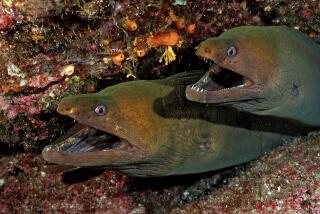Not your everyday bird sighting
- Share via
Hark, the red-flanked bluetail sings!
Yes, that red-flanked bluetail — the bird species that until this week had been spotted just once in North America outside of Alaska.
Avid birders have been vocalizing like crazy about the discovery, which was made Tuesday by biologists on San Clemente Island, a 21-mile-long sliver off the Southern California coast.
PHOTOS: Readers share bird images
“Birders get very excited about this kind of thing,” said Kimball Garrett, ornithology collections manager at the Natural History Museum of Los Angeles County. “It just illustrates that almost anything can happen out there in the wild with birds.”
The small, thrush-like bird normally breeds in a wide area spanning Northern Europe and Northern Asia and winters mainly in Southeast Asia. A few red-flanked bluetails have been spotted in the neighborhood of the Aleutians, but the species’ only other North American engagement was 22 years ago on Southeast Farallon Island, a rocky chunk off San Francisco.
This week, researchers from the Institute for Wildlife Studies were trekking through the canyons of uninhabited San Clemente, checking on the San Clemente loggerhead shrike. The island is owned by the U.S. Navy, which is trying to aid the endangered bird’s recovery.
Jethro Runco, a member of the institute’s San Clemente team, wrote on the birding website eBird.org about coming across a bird he’d never seen — an avian he thought just might be a Siberian rubythroat.
“We followed the bird for roughly 30 minutes — 30 minutes of sheer pleasure, minds racing and hearts pumping!” he wrote. He took plenty of point-and-shoot photos and tried seven or eight times to radio his colleagues.
Back at the office, the shrike project’s supervisor, Justyn Stahl, was brushing his teeth when a grinning Runco showed him the photos.
“I threw my toothbrush on the counter and ran to my room to grab my copy of ‘Birds of East Asia,’” Runco wrote on eBird, “vaguely recalling seeing this bird during a trip to Thailand.”
Stahl, Runco and a few others raced back to the canyon. The light was fading. All they found were a couple of orange-crowned warblers — but then they saw a tiny bird with “the beautiful blue rump and tail, the cinnamon wings, the reddish flanks…
“As the sun set and the light faded,” Stahl wrote, “we hiked back out to the truck, delirious.”
How what birders call a “vagrant” wound up so far off course is unknown — but it’s hardly unprecedented, according to Garrett of the natural history museum.
“Not all individuals unerringly migrate from point A to point B,” he said. “The astounding thing is that so many birds get it right.”
More to Read
Sign up for Essential California
The most important California stories and recommendations in your inbox every morning.
You may occasionally receive promotional content from the Los Angeles Times.














